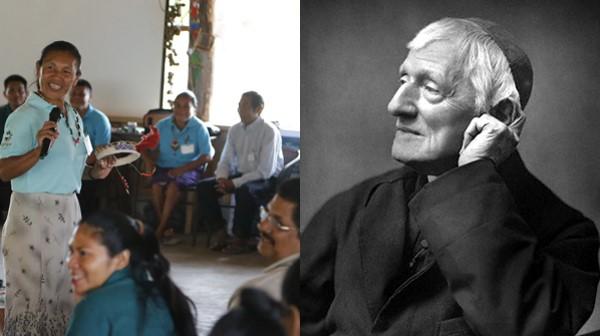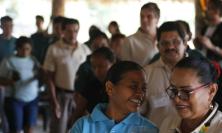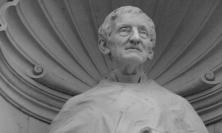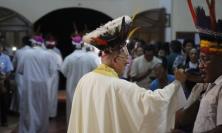‘The tradition of the Apostles manifests itself sometimes by the mouth of the episcopacy, sometimes by the doctors, sometimes by the people, sometimes by liturgies, rites, ceremonies, and customs, by events, disputes, movements, and all those other phenomena which are comprised under the name of history.’ The words of John Henry Newman, who is to be canonised on Sunday 13 October, make apt reading in the light of the Amazon Synod, says Theodora Hawksley.
The Synod on the Amazon is only in its first week, and it has already become the focus of considerable disagreement. The Catholic news media and Twittersphere are alive with reciprocal accusations of paganism and racism, two bishops have launched a ‘crusade of fasting and prayer’, and the discussion over what did or did not happen during a tree-planting ceremony in the Vatican gardens is not over yet. Were people ‘bowing down before carved images of pregnant women’? Was it ‘Our Lady of the Amazon’? If all this online warfare seems unseemly, it is worth remembering that the Council of Chalcedon involved actual beard-pulling.
Amid all the criticism and counter-criticism circulating online are more serious critiques of the Synod’s working document (Instrumentum laboris), including from Cardinal Gerhard Müller, former prefect of the Congregation for the Doctrine of the Faith.[i] Müller’s criticisms focus on what he describes as the document’s defective understanding of revelation. Revelation, he argues, is contained in Scripture and Tradition: it is not found in particular geographical territories. Müller’s critique does raise some important areas for reflection, but this particular objection seems an odd one: Catholic theology has always acknowledged ‘general’ revelation as well as the ‘special’ revelation of scripture and tradition, and Catholic social teaching has a long tradition of reflecting on the signs of the times – those social, political and historical events that demand ethical reflection and a response from the Church.[ii] That the working document reflects seriously on the ecological crisis as a sign of the times is entirely appropriate; that it does so in relation to the destruction of a particular place and the suffering of its peoples is no more remarkable than Leo XIII’s reflection on the suffering of the workers of Europe caused by the industrial revolution in his Rerum novarum (1891).[iii]
It is in this sense that the Synod on the Amazon invites us to look at the Amazon as a site of revelation: it is a situation that God is inviting us to read or listen to, and to reflect upon in light of scripture and the Church’s teaching. It is a situation in which – as in every situation – God’s will can be sought and discerned. The working document’s claim that territory in general, and the Amazon in particular, is ‘a theological place where faith is lived, and also a particular source of God’s revelation: epiphanic places where the reserve of life and wisdom for the planet is manifest, a life and wisdom that speaks of God’, is no more problematic than Benedict XVI’s statement that:
A precious treasure is to be found in the soul of Africa, where I perceive a ‘spiritual “lung” for a humanity that appears to be in a crisis of faith and hope’, on account of the extraordinary human and spiritual riches of its children, its variegated cultures, its soil and sub-soil of abundant resources.[iv]
At a press conference before the launch of the Synod, the Synod Relator Cardinal Baldisseri downplayed the criticisms of the working document circulating in advance of the Synod. ‘If there is a cardinal or a bishop who does not agree, who sees that there is content that does not correspond to church teaching,’ he said, they should understand that ‘it’s not a magisterial document. It’s a working document that serves as a basis to construct from zero the final document.’[v] The point, he emphasised, was to gather the voices of the 80,000 people consulted during the process of preparation for the Synod.[vi] Cardinal Hummes, the President of the Pan-Amazonian Ecclesial Network (REPAM) stated:
It is the voice of the local church, the voice of the church in the Amazon – of the church, of the people, of the history and of the very earth, the voice of the earth.... And this has value, it is not fake news.
He went on to add: ‘The church didn’t do it for the sake of doing it to only ignore them. No! If it was done, it was so that [the church] could listen to them. This is the synodal path: to seriously listen.’[vii]
To seriously listen: this, perhaps, is the point of connection with Newman. In an editorial for the Rambler in 1859, ‘On Consulting the Laity in Matters of Doctrine’, Newman stated that ‘One man will lay more stress on one aspect of doctrine, another on another; for myself, I am accustomed to lay great stress on the consensus fidelium.’[viii] He went on to explain,
… the body of the faithful is one of the witnesses to the fact of the tradition of revealed doctrine, and … their consensus through Christendom is the voice of the Infallible Church.
I think I am right in saying that the tradition of the Apostles, committed to the whole Church in its various constituents and functions per modum unius, manifests itself variously at various times: sometimes by the mouth of the episcopacy, sometimes by the doctors, sometimes by the people, sometimes by liturgies, rites, ceremonies, and customs, by events, disputes, movements, and all those other phenomena which are comprised under the name of history. It follows that none of these channels of tradition may be treated with disrespect; granting at the same time fully, that the gift of discerning, discriminating, defining, promulgating, and enforcing any portion of that tradition resides solely in the Ecclesia docens [the Magisterium].[ix]
The process of preparation for synods usually includes consultation of the bishops of given areas, who feed into the working document information about the challenges facing the Church in their area of pastoral responsibility. New in recent years has been the inclusion of laypeople in that process of consultation, first for the Synod on Marriage and Family Life, then for the Synod on Youth, Faith and Vocational Discernment, and now for the Synod on the Amazon. Some 80,000 people were consulted during the process of preparation for the Synod, through local gatherings held across a territory massive, remote and challenging. It is their voices, as Baldisseri points out, that are gathered in the Synod document, and the point of those gatherings was not to sort and judge – the job of the Ecclesia docens, which begins this week – but simply to listen.
This is what Newman is getting at in ‘On the Consultation of the Laity’: the importance of listening to the people, and to the faith that resides within them, as well as to bishops, liturgies, events and movements. All of these are places in which God speaks to us, and all need to be weighed and judged. When we speak of consulting the laity, Newman states, we mean ‘consult’ not in the sense of asking opinion or counsel. Rather,
… we talk of ‘consulting our barometer’ about the weather:– the barometer only attests the fact of the state of the atmosphere. In like manner, we may consult a watch or a sun-dial about the time of day. A physician consults the pulse of his patient; but not in the same sense in which his patient consults him. It is but an index of the state of his health.[x]
Newman says that we consult the laity in this way, in the same way that we consult rites and doctrines, as witnesses to the faith that resides in them. This captures in part the aim of the Synod process so far: to consult the inhabitants of the Amazon region, to ask them to speak about their faith, the challenges facing them as indigenous peoples, and the pastoral challenges facing the Church. Newman, then, is a good advocate for listening attentively to the facts.
But is that all? Are the faithful of the Amazon simply being consulted like a barometer, or like a doctor consults a pulse? Newman’s medical analogy slightly downplays something that is clear in the rest of his article: that the encounter between ‘doctor’ and ‘patient’, ecclesia docens and ecclesia discens, [xi] can be mutually transformative. The reason he engages with the theme of consulting the faithful in the first place is because of objections raised to an earlier Rambler piece, in which he had stated that, ‘in the preparation of a dogmatic definition, the faithful are consulted, as lately in the instance of the Immaculate Conception.’[xii] The example of the Immaculate Conception makes it clear that sometimes the peripheries – popular faith and devotion – can change the centre. In the ‘On Consulting the Laity’ article, Newman gives the even starker example of the Arian controversy in the fourth century, in which ‘the divine tradition committed to the infallible Church was proclaimed and maintained far more by the faithful than by the Episcopate.’[xiii] We are not in such a situation here, thank God, but Newman’s point is worth holding on to: there are times faith that resides in ordinary people can be transformative for the centre. If this is a medical consultation, it is one in which the doctor, as well as the patient, can go away healthier.
Reflecting on Newman’s medical analogy also helps us think more deeply about the dispositions that such a transformative listening encounter requires. The anthropologist Jeanne Favret–Saada’s fascinating study of witchcraft in the Bocage region of France, Deadly Words, reports the comment of a local psychiatrist that ‘Medicine round here is a veterinary art.’ Belief in witchcraft and the evil eye was widespread in the area, with the result that the psychiatrist did not trust his patients’ assessments of their symptoms or diagnoses of their illnesses. They attributed illness to the evil eye, he to psychiatric conditions: there was no shared ground of interpretation on which they could meet, and so he treated his patients more or less as a vet would treat a cow, without presuming any intelligence on their part. Müller dismisses the working document’s reference to the Amazonian cosmovision along these lines, calling it ‘a cosmovision with its myths and the ritual magic of Mother “Nature”, or its sacrifices to “gods” and spirits which scare the wits out of us.’ He goes on:
In all seriousness, in the formation of future pastors and theologians, shall the knowledge of classical and modern philosophy, of the Church Fathers, of modern theology, of the Councils now be replaced with the Amazonian cosmovision and the wisdom of the ancestors with their myths and rituals?[xiv]
Müller consistently presents it as a choice: the Amazonian cosmovision, or Christianity.[xv] There is no shared ground of understanding: the approach to indigenous people’s worldview is basically veterinary. It is true, as he points out, that not all of the traditional beliefs of indigenous peoples are healthy or compatible with Christianity. The same goes for British culture, American culture or German culture: the gospel of Jesus Christ no more permits the worship of natural forces than it permits the worship of market forces. But a real listening demands that we accept that indigenous peoples are genuinely Catholic Christians, and that there is a shared ground of belief, meaning and experience that allows a real conversation between bishops and people, centre and peripheries, ecclesia docens and ecclesia discens. Without this basic assumption, the encounter is not a medical consultation, as Newman would have it, but a veterinary one.
Newman is right that doctors do not consult patients in the same way that patients consult doctors but, nevertheless, medical encounters regularly assume a degree of intelligence and reflective ability on the part of the patient. The patient is not completely passive: in a doctor’s consulting room he is already making judgements about which of his symptoms are relevant, which most concerning and severe, and so on. The doctor may ask the patient to elaborate or question him further, or she may rate differently the importance and significance of the symptoms troubling him, but the patient is by no means consulted as an inert collection of facts. On the contrary, good medical diagnosis and successful treatment requires the doctor to engage with the patient as a whole person, possessed of intelligence and free will, hopes and fears, and bound up in relationships with others. It requires a shared ground of understanding, and a disposition of trust and charity. St Ignatius, in the Presupposition that begins the Spiritual Exercises, describes the disposition needed:
In order that both he who is giving the Spiritual Exercises, and he who is receiving them, may more help and benefit themselves, let it be presupposed that every good Christian is to be more ready to save his neighbour’s proposition than to condemn it. If he cannot save it, let him inquire how he means it; and if he means it badly, let him correct him with charity. If that is not enough, let him seek all the suitable means to bring him to mean it well, and save himself.[xvi]
Such a spirit of charity in listening, trust and encounter, both at the Synod itself and in the discussions around it, is something worth fasting and praying for.
Theodora Hawksley is responsible for Social and Environmental Programming at the London Jesuit Centre.
Thanks to Séverine Deneulin and Frank Turner SJ for their comments on an earlier version of this piece; and to Thomas Knieps-Port le Roi at the Journal of Marriage, Families and Spirituality (formally INTAMS review) for permission to reuse material from Theodora Hawksley, ‘On Consulting the Faithful in Matters of Morals’, INTAMS Review 20.1 (2014), pp.26–31.
[i] Cardinal Gerhard Müller, ‘On the Concept of Revelation as presented in the Instrumentum Laboris for the Amazon Synod’, Catholic News Agency, 16 July 2019: www.catholicnewsagency.com/news/full-test-of-cardinal-muellers-analysis-on-the-working-document-of-the-amazon-synod-78441.
[ii] Müller is correct that more theological work needs to be done to define key terms, if these are to be used in the apostolic exhortation after the Synod.
[iii] Leo XIII, Encyclical Letter Rerum Novarum (1891):
[iv] Benedict XVI, Post-synodal Apostolic Exhortation Africae munus (2001), §13.
http://w2.vatican.va/content/benedict-xvi/en/apost_exhortations/documents/hf_ben-xvi_exh_20111119_africae-munus.html. See also John Paul II’s address to Aboriginal Australians and Torres Strait Islanders in 1986: ‘You do not have to be people divided into two parts, as though an Aboriginal had to borrow the faith and life of Christianity, like a hat or a pair of shoes, from someone else who owns them. Jesus calls you to accept his words and his values into your own culture. To develop in this way will make you more than ever truly Aboriginal…Take this Gospel into your own language and way of speaking; let its spirit penetrate your communities and determine your behaviour towards each other, let it bring new strength to your stories and your ceremonies. Let the Gospel come into your hearts and renew your personal lives. The Church invites you to express the living word of Jesus in ways that speak to your Aboriginal minds and hearts. All over the world people worship God and read his word in their own language, and colour the great signs and symbols of religion with touches of their own traditions. Why should you be different from them in this regard, why should you not be allowed the happiness of being with God and each other in Aboriginal fashion?’ §12
[v] https://www.americamagazine.org/faith/2019/10/03/cardinals-hummes-and-baldisseri-respond-critics-working-document-amazon-synod
[vi] Baldisseri added: ‘It is not a pontifical document. It’s a collection of the input from the grassroots of the Amazonian people and the result of what they said in 170 assemblies and in other forums.’ Ibid.
[vii] Ibid.
[viii] John Henry Newman, ‘On Consulting the Faithful in Matters of Doctrine’, Rambler July 1859, §2:
http://newmanreader.org/works/rambler/consulting.html
[ix] Newman, ‘On Consulting the Faithful’, §2
[x] Newman, ‘On Consulting the Faithful’, §1 (emphasis original).
[xi] The ‘teaching church’ and the ‘learning church’.
[xii] Newman, ‘On Consulting the Faithful’, Introduction.
[xiii] ‘Here, of course, I must explain:—in saying this, then, undoubtedly I am not denying that the great body of the Bishops were in their internal belief orthodox; nor that there were numbers of clergy who stood by the laity, and acted as their centres and guides; nor that the laity actually received their faith, in the first instance, from the Bishops and clergy; nor that some portions of the laity were ignorant, and other portions at length corrupted, by the Arian teachers, who got possession of the sees and ordained an heretical clergy;—but I mean still, that in that time of immense confusion the divine dogma of our Lord's divinity was proclaimed, enforced, maintained, and (humanly speaking) preserved, far more by the ‘Ecclesia docta’ than by the ‘Ecclesia docens;’ that the body of the episcopate was unfaithful to its commission, while the body of the laity was faithful to its baptism; that at one time the Pope, at other times the patriarchal, metropolitan, and other great sees, at other times general councils, said what they should not have said, or did what obscured and compromised revealed truth; while, on the other hand, it was the Christian people who, under Providence, were the ecclesiastical strength of Athanasius, Hilary, Eusebius of Vercellæ, and other great solitary confessors, who would have failed without them.’ Newman, ‘On Consulting the Faithful’, §3.5
[xiv] Müller, ‘On the Concept of Revelation’, §4.
[xv] See Sandro Magister, ‘Cardinal Müller: They have driven Jesus out of the Amazon Synod,’ Lifesite News October 8 2019: https://www.lifesitenews.com/opinion/cardinal-mueller-they-have-driven-jesus-out-of-the-amazon-synod.
[xvi] Ignatius, Spiritual Exercises §22






